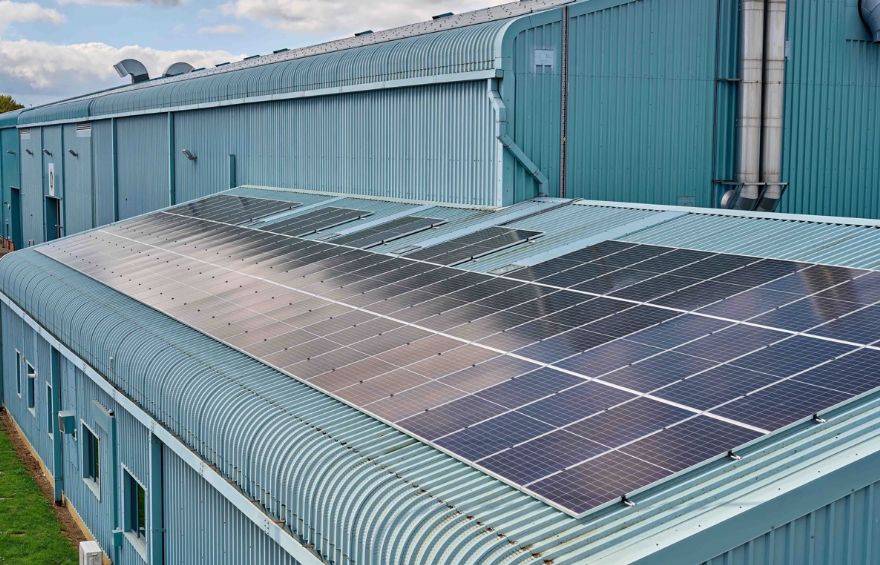 Ortus Energy completes integration of 400kW PV system for GE Power Conversion's Marine Test Facility. Photo courtesy of Ortus Energy
Ortus Energy completes integration of 400kW PV system for GE Power Conversion's Marine Test Facility. Photo courtesy of Ortus EnergyLondon-based
Ortus Energy has worked in conjunction with
GE Power Conversion UK to provide and integrate a 400kW photovoltaic (PV) system into GE’s marine power test facility in Leicestershire.
The supply of this system by Ortus has contributed a further part to GE’s journey towards carbon neutrality goals, in line with the organisation’s ongoing corporate commitment to sustainability. GE’s marine power test facility is now equipped with a 400kW roof-top system of 962 solar panels that will save around 70 tonnes of CO
2 annually and generate an estimated 315,000kW of clean energy per year to help run the facility. The 4.5-acre site is dedicated to land-based innovation, test and emulation of full-scale, multi-MW integrated electric power and propulsion systems and new energy technologies for naval and other maritime platforms.
The facility needs energy to run extensive tests on its electric ship equipment. These include both high- and low-voltage systems, AC and DC, fixed and variable frequency electrical systems which are all highly configurable and fully interconnected via the land-based, integrated marine micro grid.
The facility’s existing architecture enabled Ortus’ PV system to be accommodated and optimised to work in conjunction with GE’s energy management system and an array of existing energy sources including grid, vessel prime movers, diesel generators, energy storage, and other equipment with varying energy-demand profiles.
To help optimise the solar power utilisation, the PV system provided by Ortus was implemented as four separate but interconnectable roof-mounted arrays, to allow the best configurability into the Marine Power Test Facility’s automation and energy management system.
Greener maritime technologiesPeter Oram, sales and commercial director at GE Power Conversion UK, said of the collaborative and forward-thinking project: “The system upgrade has been conceived and integrated in such a way that all sources of energy, from fuel to grid supply, can be optimised for efficiency, carbon reduction and operating cost. It is important for the Marine Power Test Facility and the customers that rely on it, providing a full-scale demonstration of future, greener maritime technologies and their deployment within a micro grid.”
GE, an energy infrastructure leader, is already part of the UK Government’s Supply Chains for Net Zero initiative, aimed at driving industrial decarbonisation, and this latest solar project continues its mission to make operations more sustainable, as well as lowering energy bills in today’s increasingly volatile market.
Phase two will commence in early 2023 at GE Power Conversion’s systems and manufacturing facility in nearby Rugby and has the potential to be nearly five-times the size at 1.8MW output. Having recently signed a deal with international assets investment company,
Fiera Infrastructure, to deploy £100 million of investments into the UK market, Ortus Energy is a major new player when it comes to guarding against energy uncertainty and currently has 300MW of commercial and industrial solar PV projects in development.
Alistair Booth, Ortus Energy managing director, said: “We are delighted to help GE improve its environmental profile, ESG commitments and carbon footprint, as well as locking-in a sizeable portion of its energy price for 25 years, at no upfront cost. Our fully integrated approach to building, financing and operating distributed energy, streamlined the project for GE and the solar PV system will be particularly beneficial for the Marine Power Test Facility site, as it looks to decrease its reliance on grid electricity.”
Alina Osorio, president of Fiera Infrastructure, said: “We are excited about our partnership with Ortus Energy and our new business relationship with GE, with whom we share similar ESG goals and considerations. Through these partnerships we continue to grow our UK solar platform while demonstrating our commitment to deliver lasting social, community and environmental benefits.”